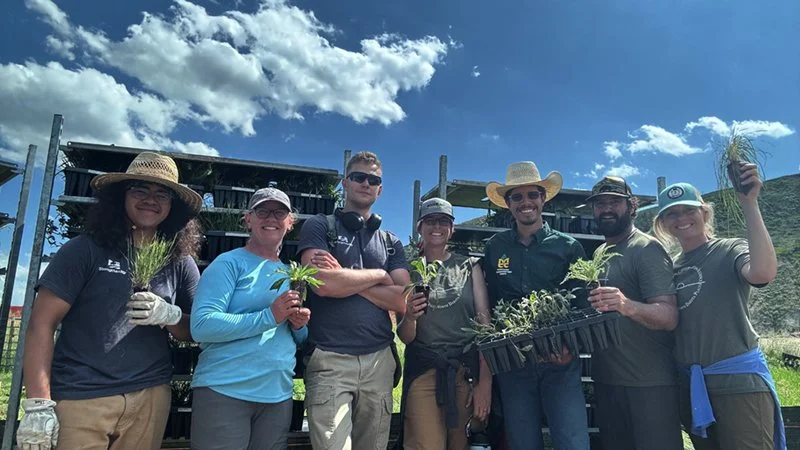Filling the Gaps in North Dakota
Preparing plants for Theodore Roosevelt Presidential Library on June 19th, 2025. From left to right: Elliot, Cara Greger, Joe, Sinaiah, Uriah (Montana Conservation Corps), Shannon Straight and Spring Bakke.
When North Dakotans hear the name Conservation Corps, it brings up the image of Civilian Conservation Corps (CCC) and Works Progress Administration (WPA) projects of the 1930s and 1940s. Famous projects in North Dakota include development of Turtle River State Park, restoration of Fort Abraham Lincoln State Park and its On-a-Slant earthlodges, and improvements to Theodore Roosevelt National Park. This New Deal program initiated during the Franklin D. Roosevelt presidency worked to employ unemployed young men.
Living in the Belfield area and talking to locals, they view the CCC and WPA projects as a positive thing for the youth who worked and for the communities that benefited from their work. I talked to an old-timer in Fryburg and he said, “We need a program like CCC to get young people working again. Teach them how to work hard.” And then I heard that Shannon and Spring were working to create a new program modeled after Conservation Corps in other states.
Cara Greger is the Western ND Conservation Coordinator for North Dakota Wildlife Federation.
Starting a Badlands Conservation Corps (BCC) is a positive direction for the state of North Dakota. Many surrounding states (Montana, Minnesota, and Iowa to name a few) have a type of Conservation Corps. The young adults work for three to six months on various projects for different agencies, nonprofits, and landowners. In Minnesota, I worked for the MNDNR where we used them to do prescribed burning, tree removal projects, noxious weed spraying, seed collection, prairie plantings and many other conservation projects. Starting a crew that focuses on the Badlands is a good way to begin building a program in ND. With federal cuts, there will be huge gaps in funding to get maintenance work on trails, fences, and infrastructure. The BCC AmeriCorps Field Crew can help fill that need for these labor-intensive projects. Connecting the crew to landowners who need support tearing out old fences and building new more wildlife-friendly fences is a good way to connect young people to the ranching community. This will help them understand how important those family ranches are to conservation in the state of North Dakota. The local communities will also show how beneficial having a Conservation Corps in North Dakota is.
From May to July of 2025, the BCC AmeriCorps Field Crew worked on multiple projects in the Badlands of ND. These projects ranged from trail improvements, building a bridge on a trail, fixing erosion problems on the Maah Daah Hey, fence removal at the new Tribal Park, preparing plants that were then planted at the Theodore Roosevelt Presidential Library, and removing fence from a landowner’s land that had been affected by the Medora 2021 wildfire. I was involved in three of these projects by either coordination, working with the crew, or both. The crew met professionals in the conservation field during their work with the National Park Service, MHA Tribal National Park, and US Forest Service. The experience gained by their work with various agencies, groups, and landowners helped connect them to future careers and expose them to on the ground work. The connection to other volunteers and landowners helps to connect them with people who use and understand this environment and have a great knowledge of the history of the area. The crew’s completed projects were great learning experiences and their work was invaluable to those they helped.


